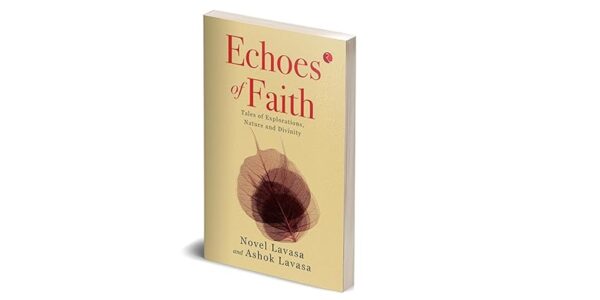Book Review: ‘Echoes of Faith’ by Novel and Ashok Lavasa
Novel Lavasa is an organic farmer and an environmentalist. Ashok Lavasa recently completed his tenure as Vice President of the Asian Development Bank. Before joining the bank, he served as Election Commissioner of India after his retirement from the government as Union Finance Secretary.
In this book, the authors share their three-decade-long journey through the places in India as well as other parts of the world that are associated with faith. They anthologized all their memories in this book that have been visited by them in three decades. And they asked questions: Is faith born out of religion, or does it come from a sense of harmony with nature’s elements? Is it strengthened by stories that hold generations together, providing them with solace and hope?
During their visit to the famous shrine of Golu Devta in Uttarakhand, the authors heard the reverberated chant ‘Jai Nyay Devta Golu, apki jai ho (All hail Golu Devta) in the temple. Along with the chants, there were thousands of devotees religiously ringing the bells. Golu Devta is considered the brave son of the Katyuri king Jhal Rai and his wife Kalinka. Oral legends suggest that he was an army general of the Chand King Baz Bahadur in the seventeenth century. They (the authors) note a popular story about Golu Devta and his childhood in the book… Golu Devta had a special place for people in his heart and would hear about their problems and help them in any way possible; people have faith in it.
* Click to Follow Voice of Ladakh on WhatsApp *
Novel and Ashok Lavasa share their experiences while visiting the Dargah Sharif of Hazrat Khwaja Moinuddin Chisty in Ajmer. It is considered one of the holiest places of worship in India, not only for Muslims but also for people of other faiths. They also add that it is believed that the Mughal King Akbar walked from Agra to Ajmer to pray at Darga Sharif when he wanted to be blessed with an offspring. He later came to be known as Jahangir. It is believed that those who make a wish tie a dhaga (thread) at the dargah. Inside the dargah, there are two deghs (pots) for cooking niaz (vegetarian food cooked with rice, ghee, nuts, etc.) for the pilgrims.
In one chapter of the book, they mentioned the Hemis Monastery, a Tibetan Buddhist monastery of the Drukpa lineage, located in Hemis, Ladakh. About 45 km from Leh, this monastery was re-established in 1672 by the Ladakhi king Sengge Namgyal. The authors visited the monastery many times in the last three decades, they said. Students of the monastery put up cultural programmes and performances. Opposite of this is a large gate-like structure, which displays the most expensive and precious thankhas (also spelled thangkas; tapestries with religious motifs, symbols, and pictures). The monastery is also an institution for teaching Tantric Vajrayana.
Apart from this, in Ladakh, a place that attracts them in Thiksey Gompa is the Maitreya (future Buddha) Temple, erected to commemorate the visit of the 14th Dalai Lama to this monastery back in 1970. The special feature of this monastery is that the 14th Dalai Lama is portrayed, rather unusually, as seated in a lotus position instead of his usual representations, in which he is shown standing or in a sitting posture on a high throne.
Readers should read this book. Since this book covers various mosques, temples, monasteries, and darghas, it provides a good account of these authors’ three decades of journeys, travelling from place to place and exploring their set of beliefs and narratives that have become part of their local culture.



0 Comments